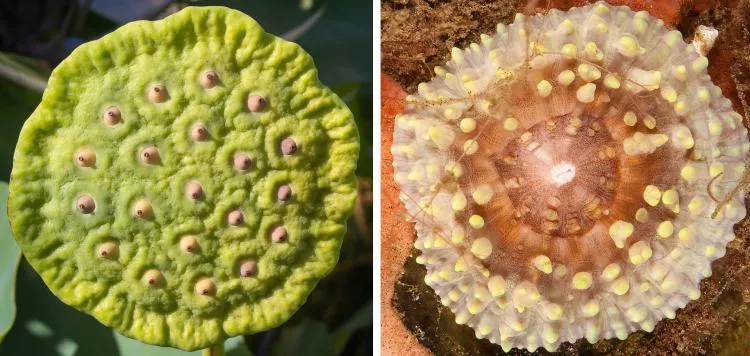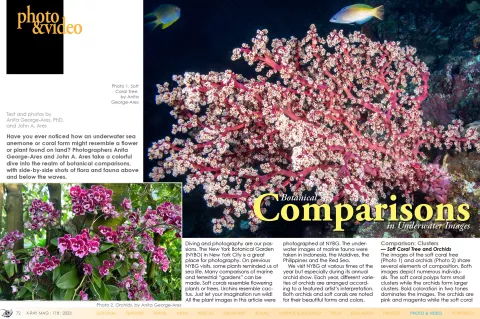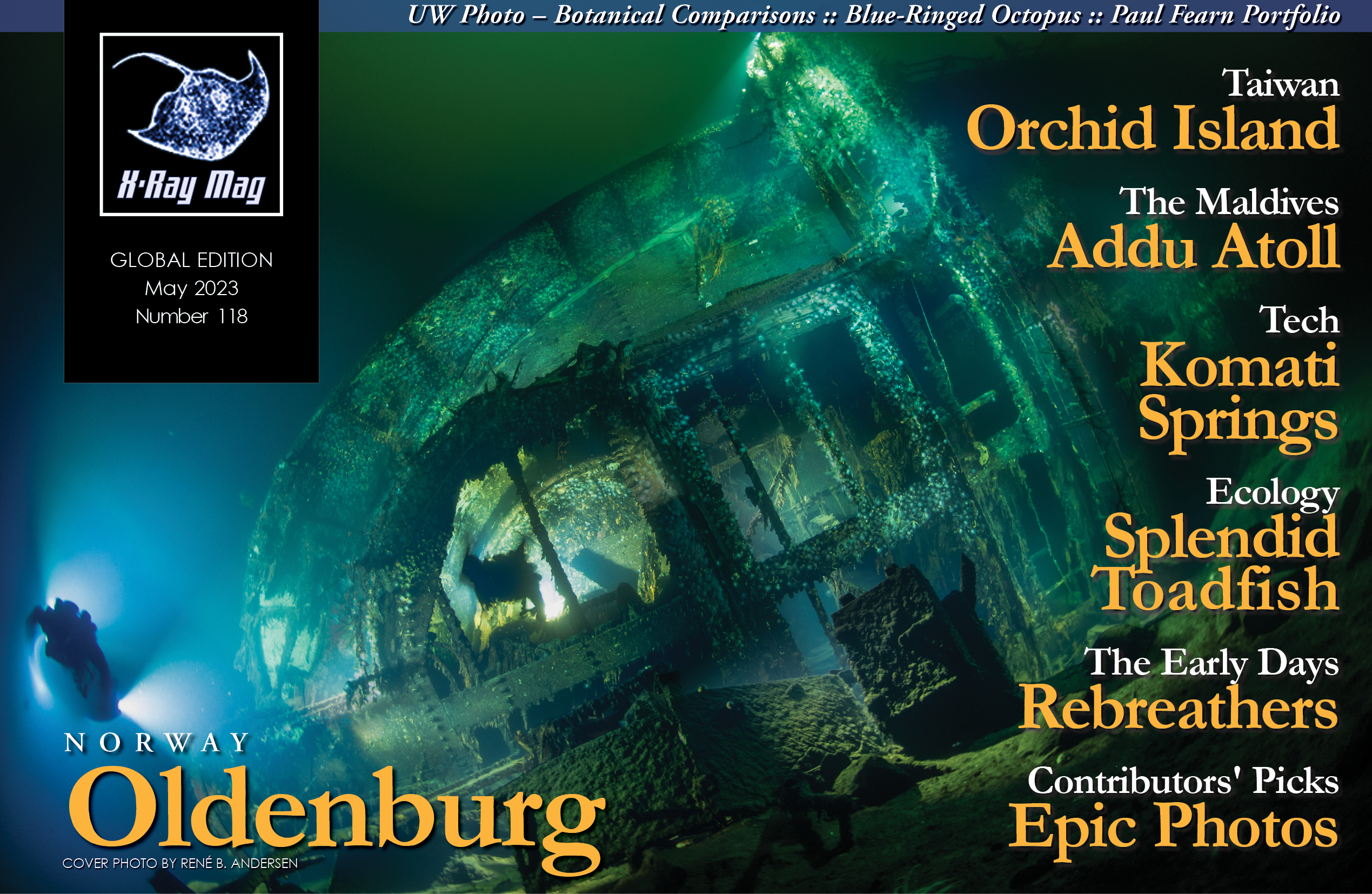Have you ever noticed how an underwater sea anemone or coral form might resemble a flower or plant found on land? Photographers Anita George-Ares and John A. Ares take a colorful dive into the realm of botanical comparisons, with side-by-side shots of flora and fauna above and below the waves.
Contributed by
Diving and photography are our passions. The New York Botanical Garden (NYBG) in New York City is a great place for photography. On previous NYBG visits, some plants reminded us of sea life. Many comparisons of marine and terrestrial “gardens” can be made. Soft corals resemble flowering plants or trees. Urchins resemble cactus. Just let your imagination run wild! All the plant images in this article were photographed at NYBG. The underwater images of marine fauna were taken in Indonesia, the Maldives, the Philippines and the Red Sea.
We visit NYBG at various times of the year but especially during its annual orchid show. Each year, different varieties of orchids are arranged according to a featured artist’s interpretation. Both orchids and soft corals are noted for their beautiful forms and colors.

Comparison: Clusters
— Soft Coral Tree and Orchids
The images of the soft coral tree (Photo 1) and orchids (Photo 2) share several elements of composition. Both images depict numerous individuals. The soft coral polyps form small clusters while the orchids form larger clusters. Bold coloration in two tones dominates the images. The orchids are pink and magenta while the soft coral is pink and white. The soft coral and the orchids display branching forms in a horizontal orientation.

Comparison: In the Field
— Anita and Orchids and Anita and Soft Corals
The image of Anita photographing orchids (Photo 3) is compared to the image of her swimming by magenta and pink soft corals off Ras Mohammed in the Red Sea (Photo 4). The orchids and the soft corals both form a wall of bright colors.

Comparison: Muted & Feathery
— Maui Wormwood and Xenia Soft Corals
Maui wormwood in Photo 5 is a rare Hawaiian plant species that only grows in the wild at the top of the Haleakala volcano. Fortunately, the attractive plant is grown at the NYBG and in nurseries. In Photo 6, the Xenia soft corals form a dense garden of different species. Both images feature a composition of muted coloration and feathery projections. The luxuriant, silvery-green plants fill the frame, as do the luxuriant soft corals.

Comparison: Plates
— Elephant Ear Anemones and Giant Lily Pads
Circular patterns are common in nature. Many examples are found among the corallimorpharians, or corallimorphs. Corallimorphs are closely related to hard corals but resemble sea anemones.
Elephant ear anemones (Photo 7) are the largest among the corallimorph species. The world’s largest water lily species is the Queen Victoria’s water lily in Photo 8. Both the lily pads and the corallimorphs form groups of yellowish-green, circular plates with raised edges. The lily pads float on the water surface, while the corallimorphs appear to “float” over the bottom.
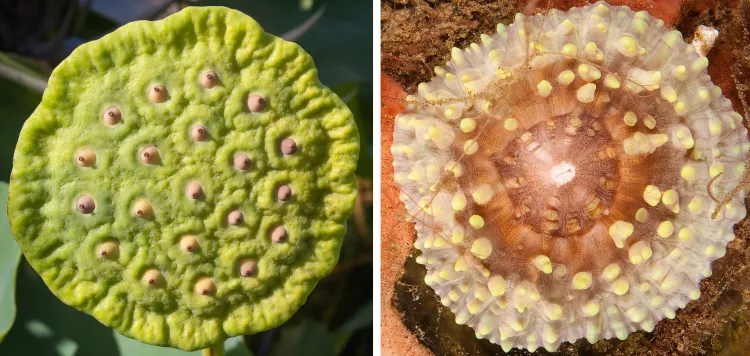
Comparison: Circular
— A Corallimorph and A Lotus Flower Pod
A lotus flower pod (Photo 9) contains hundreds of seeds. As the seed pod develops, its shape and color changes. Photo 10 shows a species of corallimorph. Both images have similar compositions where the lotus pod and the corallimorph are circular and fill the frames. The radial symmetry of the corallimorph’s short yellow tentacles resembles the radial symmetry of the yellow and pink seeds in the pod. Conspicuous borders are shared by both the corallimorph and lotus pod.
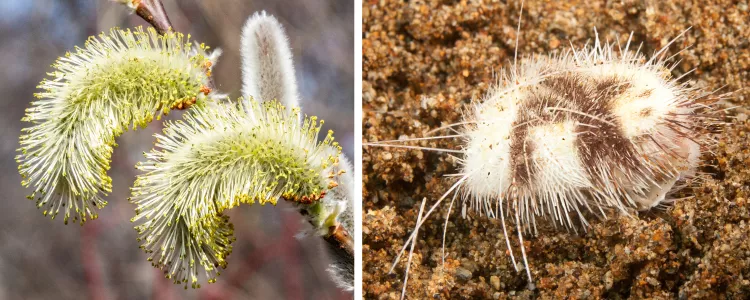
Comparison: Fuzzy
— Hearth Heart Urchin and Willow Catkin
Willow catkins (Photo 11) are flower clusters that appear in the spring before the willow tree produces leaves. Hearth heart urchins (Photo 12) live in burrows and crawl on the bottom in search of food. The fuzzy catkins resemble the fuzzy urchin. Both the catkins and urchin share muted coloration. With the exception of a few long spines, most of the urchin spines are of uniform length. The spikes of the catkins are also of uniform length.
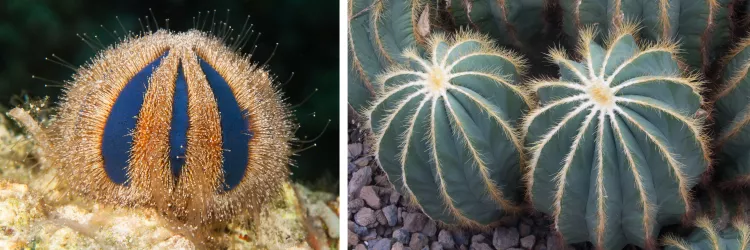
Comparison: Spiny
— Globe Urchin and Cacti
The NYBG has a desert section that displays cacti and succulents of various species and morphology. Some cacti with their shapes and spines resemble sea urchins. Both the urchin (Photo 13) and the cacti (Photo 14) have similar shapes. Each “globe” has radiating lines bearing golden spines against a uniform color background. The radiating lines connect to central points on top of the urchin and cacti.
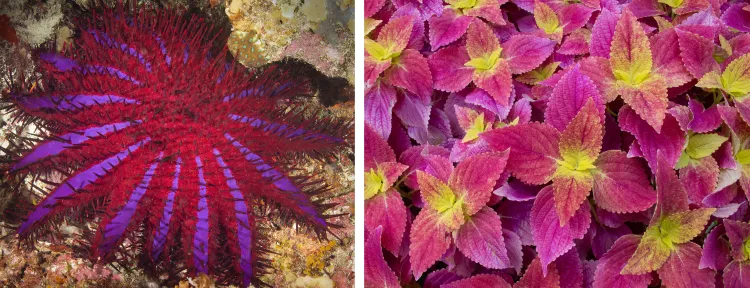
Comparison: Bright Colors
— Coleus Plant and Crown-of-Thorns Sea Star
Coleus plants (Photo 15) are featured at NYBG and come in many varieties. The attractive foliage makes Coleus a favorite ornamental plant. Like the Coleus, a crown-of-thorns sea star (Photo 16) varies in color. Bright colors in nature are sometimes a warning of toxicity. The spines of crown-of-thorns sea stars contain a toxin that is released in puncture wounds resulting from contact. The leaves of the Coleus plants are mildly toxic to humans and may cause a rash upon contact. Both the sea star and Coleus images have radial symmetry and bold, two-color patterns.
Developing an eye for photography
As photographers, we always look for interesting subjects to shoot, both on land and underwater. One does not necessarily have to shoot the obvious. We keep our eyes open for the not-so-obvious subject matter such as subtle shapes and forms, different angles and compelling compositions. John and pioneering underwater photographer Ernie Brooks once got into a discussion about black-and-white underwater photography at the Beneath the Sea Exposition in New Jersey. Ernie emphasized “shoot for form,” a lesson that we have taken to heart.
Photographic creativity is influenced by how one sees. A critical asset in enhancing one’s ability to see is one’s passion for being outdoors and observing nature. We are often intrigued and inspired by the similarities we find in the shapes and forms of flora and fauna in the botanical and underwater realms.
If one is passionate about experiencing nature, whether topside or underwater, then it is likely that one will look more closely and recognize patterns of form and color. If you share the joy of observing nature, then you already have what you need to start your own photographic journey of discovery. Who knows what you will find… The discoveries are endless! We encourage you to take the challenge: Go out and look at the world—and notice the diversity and similarities of shapes and forms in nature.
Reference:
Barnbaum, B. (2017). The Art of Photography, A Personal Approach to Artistic Expression. Rockynook Inc. 393 pp. A useful reference, particularly the chapters on composition, visualization and light.

